

David Hostetter from SCS Engineers and Dennis Siegel from WM (Waste Management) join Inductive Automation to talk about the unique processes and challenges within the waste management industry, from residential to the engineering and life cycles of landfills. They discuss how operational improvements in this essential service and its environmental footprint are making the industry more sustainable. They dive into the 24/7 maintenance and monitoring of landfills, adjusting to changing conditions in real-time, reducing cost, generating renewable energy, improving the health and safety of operators, and being proactive in a changing world. These landfill systems, such as WM’s Connected Landfills are improving connectivity, mobility, and visualization by using data science to facilitate better decisions.
Visit the SCS RMC site. Learn more about Sustainability in Waste Management.
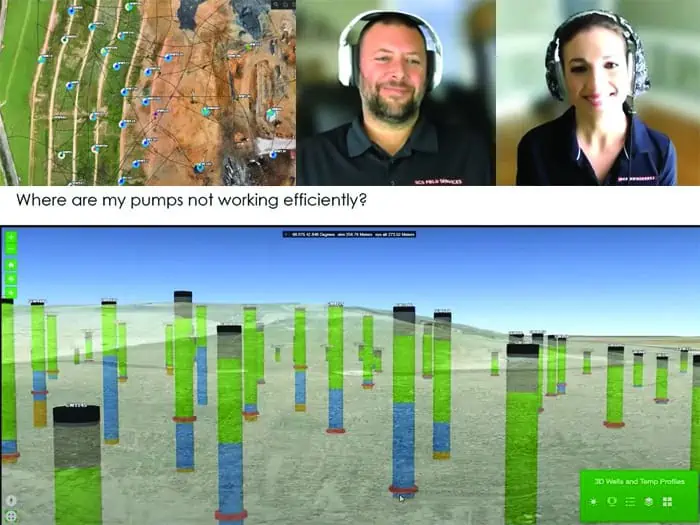
Great innovations take shape when people with shared ambitions, high energy, and creative juices pool their talents and gusto. Meet two professionals at SCS Engineers, who, through their mutual entrepreneurial spirits, found a resourceful way to create landfill efficiencies for operators — saving time and money. Here’s the story of Chris Carver and Joy Stephens — and a service they helped develop, leveraging cutting-edge technology that’s been a game changer for landfill efficiency.
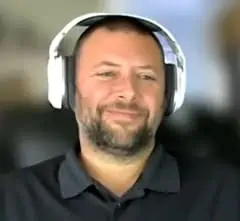
Chris Carver joined SCS Engineers soon after coming out of the military, where he served as an infantry soldier, protecting our country from threats on the ground. Brand new to landfill operations, the now 17-year SCS veteran started out dropping pipes and installing gas collection and control system (GCCS) components.
“But I was hungry to know how all the pieces fit together. I wanted to understand what made these complex systems work and everything they could do,” Carver recalls.
The more he asked, the more he learned, and with that knowledge came new opportunities. He climbed from laborer to field technician to landfill project manager. And, finally, to tech guru, building and managing powerful databases.

Not long after he’d moved into the IT space, Carver met Joy Stephens; a teacher turned environmental scientist who also did some data processing. They would enter a working relationship about shared learning and feed on each other’s curiosity and knowledge. Their synergy would play a key role in SCS’s GIS services integration with SCS RMC®. By leveraging GIS technology, the duo created site-specific, detailed digital maps that enable operators to visualize what’s happening in the field in real-time. Landfill and environmental staff are continually informed, allowing immediate action when needed. The operation is supporting about 117 patrons around the country and growing quickly.
Carver and Stephens met while working at a Tennessee landfill.
He oversaw field operations, monitoring and managing liquid levels, gas extraction wells, and surface emissions. And he was facilitating the transition to a digital platform to manage and use the field data better.
Stephens processed the data and helped him prepare operations, monitoring, and maintenance reports, which Carver used to identify trends and determine how to improve field operations. She generated those reports mainly from the field tech’s handwritten notes in those days.
In between their office dialogues, Stephens would follow him into the field, curious to see how he and the landfill techs worked.
“We began talking about how we could collect more and different types of data and use it to make the field techs’ and operators’ jobs easier while boosting their efficiency,” she says.
Plenty has transpired since those early conversations, and they continue to take their work further, dedicated now to SCS’s GIS Services, launched under the company’s Remote Monitoring Control Group.
Today, Carver and Stephens make digital forms and maps –Self-Monitoring Analysis and Reporting Technology (aka SMART)—the smartest they can be.
As the system grows in sophistication, clients tap into more information, in more detail, on GCCS, liquid management, and other landfill operations.
Stephens’ bailiwick is creating the smart forms field techs fill out from an app and upload to the cloud, replacing those cumbersome logbooks they used to lug, then bring to her. She also designs maps that connect to and pull information from the forms to visualize the information. She’s a mavin at capturing specific data points that operators look for and formatting the maps to deliver easy-to-read visuals of a lot of information.
Carver’s job is to manage the behind-the-scenes workings of the software to ensure the smart forms and maps perform as designed. There’s a lot of organizing and processing that goes on.
It requires fluency in multiple programming languages to customize functionality for each client. He may need to build in constraints and immediately visible liquid level calculations, write scripts to pull meteorological data from a weather station into a smart form, or script to automate tedious tasks such as parsing temperature probe data.
Stepping back in time, Carver says, “When Joy and I started working together, I was the Google maps guy. I incorporated data in Google maps to guide the field techs to the site locations needing their attention. Then Joy said, have you heard of GIS?”
It was more sophisticated. It could pick up on site-specific details that Google maps couldn’t.
“She showed me how the mapping and visualization worked. We could see liquid column heights in gas wells, fluctuating gas quality, and other actionable details. We would actually be able to monitor the overall health of each well and multiple other operations. I fell in love with it,” Carver says.
That’s when Stephens began creating maps connecting to the digital forms she’d been developing, allowing Carver to identify where to focus quickly.
“It helped me increase efficiency in the field, and our projects gained traction,” he says.
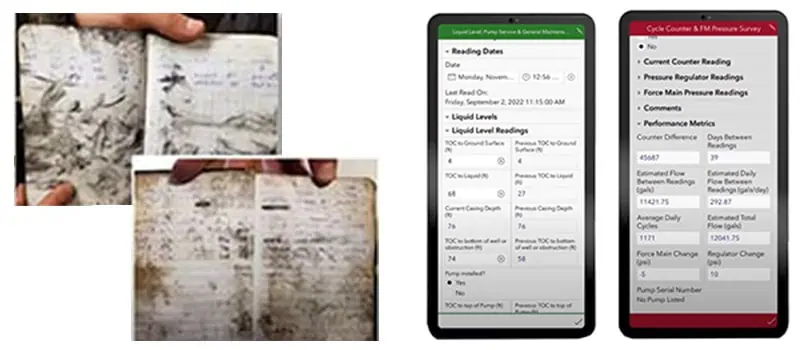
Stephens, like Carver, continually seeks to know more.
“In those early days when I went out in the field with Chris, I’d ask a ton of questions to understand better what information to capture and incorporate into the forms. Why are we monitoring this? What constitutes good gas quality? Why is it important to know liquid levels?” Stephens reflects.
They were the same questions Carver had asked years before, and he was impressed.
“I wanted a smart, curious partner who would move things along. And that is Joy,” says the equally curious and ambitious techie who taught himself how to code when building a website for his son’s baseball team.
As colleagues and friends, they have taken GIS capabilities beyond monitoring and analyzing field conditions. Now the system connects to IoT technology, enabling operators to take action remotely, whether increasing or reducing gas flow or turning dewatering pumps on or off, among measures.
They have mastered another skill set to capture and layer in more data. They’ve become drone pilots, flying unmanned aircraft over landfills to record methane emissions-related information from locations hard or unsafe to reach by foot.
As co-pilots, they share another interest beyond teaching, learning, and making technology do what they want.
It’s a time to experience their mutual affinity for the outdoors, take in their surroundings, and reassert that what they do is more than worthwhile.
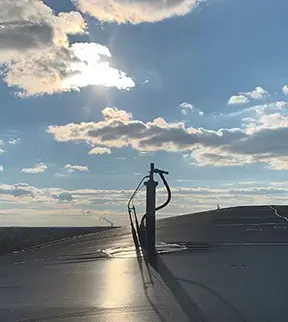
“The top deck of the landfill, where Joy and I do our drone flights, is one of the most beautiful places. Depending on the part of the country, you see the woodland and mountains for miles. And get spectacular views of the town,” Carver says.
Stephens recalls an especially memorable flight on the East Coast getting methane emissions readings.
“We were gazing upward, and a pair of bald eagles on the landfill were soaring above us. It was one of those moments where we just looked at each other in awe.”
Later they talked about how that moment reminded them of what they do and why they do it.
“There is this incredible world around us. In responsibly managing landfills, with their important role in keeping communities clean and capturing climate-impacting methane, we help to preserve that world,” Stephens says.
Carver chimes in: “I think sometimes people lose sight of the fact that when we are gone, we leave this planet to our kids. Whatever we can do to improve it for them and their kids … that’s a good motivator for me.”
Click to learn more about
Click to learn more about environmental careers at SCS Engineers.
Join SCS’s next educational forum on remote monitoring and control technologies.
While performing methane reduction operations and monitoring at the Anchorage Regional Landfill in Alaska, members of the SCS RMC drone team met some pretty amazing people, including Shane Christiansen who works for the Municipality of Anchorage. The RMC team got to know Shane and learned how he and his business partner, Tim Harrington, are helping disabled children.
Shane and Tim run an organization called Children Leaving Tracks (CLT) that has the mission of providing mobile technologies to young people with limited mobility, allowing them to participate more fully in everyday activities with their peers. They believe that providing improved mobility can expand the physical and mental well-being of these kids and offer them greater freedom and quality of life.
Moved by Shane and Tim’s passion and dedication, SCS made a donation, which will provide “Electric All-Terrain Trikes” to three children! “Everyone deserves to have these experiences in life, but unfortunately this kind of technology is not always covered by insurance companies,” says Shane. “This means that some people go their entire life without getting to enjoy all that it has to offer. They don’t have the freedom to [move about] as they please.”
Although still in the early stages, Children Leaving Tracks seeks financial and in-kind donations from sponsors and networking partners. They are working toward creating a corporate/private collaboration that has the single mission of helping disabled children become more mobile for their health and personal growth.
CLT uses funding to run the organization to supply and finance Track Chairs and Electric Trikes. Donations cover the costs of purchasing and shipping these chairs to the kids who need them. Shane and Tim are registering Children Leaving Tracks as a 501c3 non-profit company; they are also starting a parent company aimed to be the primary funding arm that will supply a percentage of revenues from more recreational products it plans to develop.
The ultimate goal is to change the lives of hundreds of children by opening up their world through greater mobility and freedom. The organization helps youngsters gain confidence, better mental and physical health, and create greater opportunities to expand their individual talents. Kudos to Children Leaving Tracks!
Learn more about how this inspirational organization uses new technology to make life better; or to help, please contact Shane Christiansen at 1-907-529-5153.
If you would like to know more about using technology to improve the environment, ask SCS click here.
SCS Engineers shows you in this short video featuring SCS Remote Monitoring & Control technology built for landfill owners and operators, solar farms, and for use on pipelines by SCS Engineers, landfill and environmental practitioners.
The Central Penn Business Journal selected SCS Engineers’ David P. Hostetter, PE, LEED AP, and CEM, as a 2021 Forty Under 40 recipient. The Journal editors recognize young individuals for successful professional accomplishments, community service, and commitment to inspiring positive change.
Hostetter combines his engineering expertise with technology to reduce industrial environmental impacts in Pennsylvania. As the Business Manager for SCS’s Remote Monitoring and Controls (RMC), he is responsible for managing and building environmental solutions to identify and reduce potential greenhouse gas emissions, which protects the health and welfare of workers and air and water qualities.
Dave believes that it is his responsibility to give back to other young professionals through mentoring. He says, “I was blessed to have Tom Conrad, a co-founder of SCS Engineers, mentor me at the beginning of my career with SCS.” Now retired, Tom Conrad is also receiving recognition for his lifelong work protecting the environment.
The local and global communities also benefit from Hostetter’s work as a small-group leader and children’s Sunday-school teacher at his church in Lancaster and co-sponsorship of the Eagle Scout’s construction of a disc golf course in northern Lancaster County. He has served with Habitat for Humanity and worked with Cure International to perform an energy audit of an overseas hospital.
Suzanne Fischer-Huettner, Senior Group Publisher of the Central Penn Business Journal, said, “These honorees help to make Central Pennsylvania a wonderful place to live and to work. The Central Penn Business Journal is pleased to celebrate their accomplishments.”
A celebration of these young professionals is scheduled on October 14 in Harrisburg, pending health precautions. The Journal will profile all of the Honorees in its October 15 edition available online at CPBJ.com.
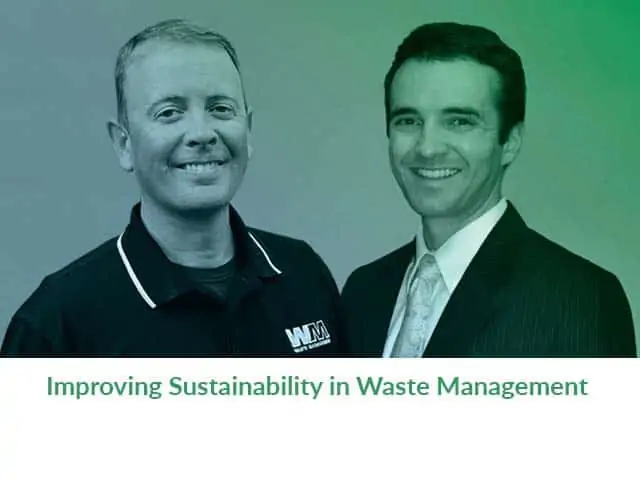
Dave and Dennis discuss how operational improvements are being made in this essential service and its environmental footprint. They dive into the 24/7 maintenance and monitoring of landfills, adjusting to changing conditions in real-time, reducing cost, generating renewable energy, improving the health and safety of operators, and being proactive in a changing world. We also hear about an Ignition-based solution called Connected Landfills that improves connectivity, mobility, and visualization by using data science to facilitate better decisions.
Apple Podcasts | Spotify | Google Play | PodBean | TuneIn
When Melissa Russo’s boss Phil Carrillo told her he thought she should get her drone pilot license, she thought he was kidding. At the time, she worked on SCS’s Remote Control (RMC) team; selling drone services was a part of her job, but she had not thought of flying these unmanned vehicles herself.
Her thirst for competition kicked in when he turned the proposition into a bet. He was going after his pilot license himself; she bet she’d beat his score. They finished in a dead heat, but what started as friendly rivalry ended up bringing a new dimension to Russo’s job— a job that continues to expand in breadth as new opportunities turn up.
Today she not only flies, sells drone services, and teaches others how to sell and fly, but she’s helped bring geographical information systems (GIS) into RMC’s portfolio. How these technologies fit together is RMC remotely collects data from drones and different landfill systems. Then the GIS translates that data into maps, capturing a visual picture of how clients’ facilities’ systems are performing. The GIS piece is one of the latest chapters in the story of Russo’s evolving role (more to come on that).
Piloting is what especially gets her juices going.
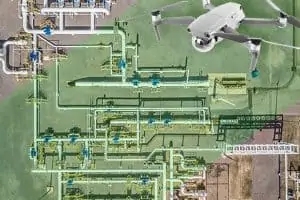
“I love working with my team, supporting them in what they do. But when it comes to drones, I like the hands-on experience of flying myself more than telling other people how to do it.”
She controls these small aircraft from a device on the ground, sharply focused on her surroundings while keeping the drone in her sight at all times.
“You have to make sure there are no manned vehicles around; they have the right of way. And there’s a lot of continuous movement on landfills. You’re constantly aware of your surroundings. Is a truck coming? Am I in line with where dumping is going on?”
Flying drones takes muscle and mechanical aptitude.
The drone and case can weigh 45 pounds. And there are a lot of moving parts to assemble and calibrate.
Sometimes it’s manual work, pointing and rotating a remote controller to send a radio signal to tell the drone what to do. But more often, she pilots automated flights that she maps in advance and uploads the flight path specs into software that interfaces with the drone.
“When I’m flying drones, I can access areas where if I had boots on the ground, I couldn’t. I can go and explore just about anywhere, similar to when I dream— only it’s real,” she says.
With any task, she’s laser-focused, concentrating on one part of the picture at a time to grasp the details. She steps back and uses critical thinking, accumulated knowledge, and imagination to take on what’s before her.
The innovation process
“We’re pretty lucky with our timing; new and proven technologies are emerging quickly. I’m one of many SCSers with a deep knowledge of technology and practical experience in the solid waste industry. Together, we can make a difference because we understand the business and operational challenges very well. When I need an expert in another industry, I just reach out to a colleague. The learning process never ends, and each project helps me and my team constantly find better answers.
“My boss is more of a big-picture person; his ideas are huge and amazing. He comes to me with new ideas, and I figure out how to make them work and implement them,” Russo says.
She points to his idea to use proven GIS technology within RMC. She was already using GIS to map methane data, process topographic maps, and stockpile calculations. For instance, she integrates methane values into the GIS and overlaps them with imagery so her clients can zoom in on one well or get a large-scale view of the overall health of the gas collection system. But integrating GIS in new ways to incorporate multiple landfill systems would solve some expensive problems and, better yet, prevent even more expensive mitigation and repairs.
Expanding GIS applications to illustrate multiple landfill systems
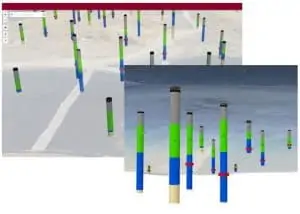
“I know drones and how to process drone data. But now that we are expanding applications, I add more layers of landfill data, such as liquids, soil, the gas collection and control system (GCCS), SCADA, and surface emissions, to bring them into the RMC GIS platform. My colleagues are demonstrating these technologies at the SCS June Client Webinar.”
“I created a team of hand-picked SCS staff with both GIS and waste management backgrounds (and a whole lot of drive) to make the vision come to life,” she says. “That’s how we innovate, tight teams with access to nationwide expertise.”
Within six months of the project’s genesis, Russo and her team had integrated gas and liquid collection systems, other landfill systems, and asset management into the RMC GIS platform. She and her team now sell these applications nationwide.
Russo’s come a long way since joining SCS at age 21
In her mind, she grew up at the company. Before coming on board, she managed a shop in Manhattan Beach, California, while she began thinking about what to do next.
“I learned a lot about business and people. It was a stepping-stone – I discovered how to earn trust, build rapport, and sell. But in time, I decided I wanted a more professional job,” she recalls.
She went to work for a real estate company managing the SCS Engineers Long Beach office, where she would soon take an entry-level Accounts Payable position in SCS Field Services.
In time, she transitioned to the Health and Safety group, assisting in creating training material and managing truck fleets. Soon she was managing assets, among other firsts for her. By this point, she had developed enough software, accounting, and other administrative skills to step up fast.
Part of the job was keeping up with vehicle maintenance, so she often spoke with field staff. Many of them she already knew from her days working in the accounting department.
Growing with her SCS colleagues
“When I was in my first administrative roles, I supported many colleagues who were field techs or supervisors; they are project managers now. It feels as though we’ve grown up together, and we know and trust each other. We collaborate well and know that when we bring projects to each other that we will take care of each other,” Russo says.
She especially likes the RMC concept because remote control and automation enable her, her clients, and her team to work smarter, not harder because they leverage the technology to work for them.
“That means we can usually work from anywhere, giving all of us more time for family, friends, or allocating the time saved towards other needed to-dos. I’m up at five a.m. and, at times, may not finish work until nine at night. Somehow, us working women find the balance in between meetings, writing proposals, and answering emails; I have lunch with my two boys or take them to a park,” she says.
Bambi Lance, a veteran SCSer and her mother, works in the same business unit as Melissa does. “Mom’s been here for 16 years, and it’s interesting to have her perspective not only as my mom but as someone who knows SCS. She knows my department, and she knows me. She sees what I am doing and she along with management encourage me to do more and believe in myself.”
Russo reflects again on the concept of stepping-stones on the way to knowledge and maturity. I’m competitive and take on challenges, which has been a driving force in all I do today. It’s helped me take a personal inventory of how I am now versus the young Melissa,” she says.
She uses it to gauge her direction. And she uses it to connect to her staff. “I try to help them see you can turn almost any experience, into a positive. I want my team to see we are all learning and growing. They can, as I can, comfortably bring new ideas to the group and company, which often turn into new ways to help clients.”
She circles back to her decision to fly drones, explaining how it aligns with her career path from her first steps to today. “Becoming a pilot was a natural fit because it’s a new challenge. The craving to take on new tasks is how I grew from an accounting administrator to a project coordinator up to a business manager. It’s wanting to expand my knowledge, tackle new feats, and accomplish what I was not sure I could do. I like the challenge.”
The SCS Culture is Driven by Client Success
David Hostetter, Sam Rice, Joy Stephens, and Chris Woloszyn take us on a landfill technology journey in their recent EM Magazine article. It is amazing what these YPs are developing and implementing nationwide. The future looks bright!
Most equipment data and system data are collected manually for regulatory compliance; this process is time-consuming, expensive, and sometimes dangerous. Consequently, some sites only collect a few data points per day, which may not provide a complete picture of landfill operations. They also contend with the control and maintenance of remote equipment. These YPs explain how they’ve solved these challenges using RMC and SCADA systems.
Field technicians—heavily laden with instruments, printed data collection sheets, logbooks, clipboards, maps, and other gear—spend long days collecting immense amounts of data. Additional labor awaits supervisors and managers as they transcribe, digitize, or otherwise prepare the data for analysis. This team deciphers the information recorded on sheets and logbooks, often accompanied by leachate stains, mud spatters, and water damage. GIS provides a low-cost way to streamline data collection, track progress, visualize task completion, and analyze collected data to deliver an overview of the landfill’s status.
Beyond cameras, various sensors can be attached to a drone. These sensors range from infrared cameras to LiDAR sensors to gas identification tools. One such tool helps identify the presence of methane leaking out of a landfill. A drone pilot can maneuver over the entire landfill, sniffing out methane leaks and seeking out poor landfill-cover integrity, all in a matter of hours. Drones collect methane data quickly and accurately without the need for traversing the ground on foot or by vehicle.
Integration of additional automatic and manual data collection methods, such as quarterly or annual drone flights, RMC systems, and remotely monitored and controlled wellheads, provide a comprehensive view of landfill performance and overall condition. UAVs or drones allow for safe inspections, quick data gathering, and lower operating costs.
Read EM Magazine’s full article with images here.
SCS is also providing a non-commercial webinar on drone technologies providing the best return on investment in March 2021. View the recording in our Learning Center after March 24, 2021.
Our industry is in a period of a rapid transition to digital data management, but particularly on landfills. Often you read that the latest technology, whether by a brilliant programmer or rolling out as part of a takeover, is innovative. Linking technology and innovation is becoming commonplace, but they are not the same. Innovation is a human process requiring experimentation and iteration to solve landfill issues that often have nothing to do with computers or mobile phones. Landfill technology or apps are tools.
Innovation takes a team of diverse expertise, different perspectives with a constant desire to learn, and most importantly, the primary desire to make landfill operations more efficient and safe. Innovators use technology when and how it makes sense to improve environmental management, profitability, and care for employees and the local community. Lower cost solutions for the vast amount of data collection completed faster and without human error come from people with hands-on in-the-field experience. When it comes to landfill technology, its value is clear when a landfill practitioner demonstrates how the particular technology fits into a solution. The nice part is they also get to the point and skip the tech-speak and jargon.
The Landfill Technology Evolution Started Here in 2003
Back in 2003, SCS couldn’t find technology that would enable our engineers and technicians to support landfill operations as we desired. Proving the proverb “necessity is the mother of invention,” we developed a database for our use. Its value in the field was immediate, and SCS continued to adapt and develop SCS DataServices® and SCS MobileTools®, basing refinements on each landfill and client need. It took people in the waste industry to make the right technology tools for the industry.

Meet Oliver Early, SCS’s DataServices and MobileTools Product Manager. Oliver started his career managing landfill operations. He became interested in technology because it got results for him as a landfill manager of 15 facilities. By combining a comprehensive investigation of physical landfill systems, such as landfill gas collection and control and other environmental monitoring and control systems with evaluations of compliance areas, he improved his landfill system performance and substantially increased power plant production. He used multivariate data techniques, including time series and network analysis, to scrutinize and refine results. Merging DataServices capabilities under Oliver’s guidance took SCS’s original internal database to a timesaving product for all landfills, not just the landfills SCS operates.
The platform, called SCS eTools®, includes modules for leachate, groundwater, DataServices, and the newest application SCS MobileTools, free for those using DataServices. The technology is currently in use on over 630 landfills nationwide and benefits all of SCS’s design, build, and operations work.
For example, if methane readings at a gas probe are elevated, that’s an indication of a potential LFG migration issue. While expertise is great – it could take hours to diagnose and mitigate. With DataServices, you could run an evaluation of the existing well field in a few minutes, ruling out issues with current wells. With the touch of a button, you can share the information with your team and focus on potential mitigation recommendations.
Remote Monitoring and Control Technology Didn’t Happen Overnight Either
The best and most innovative solutions come from combining the stakeholders’ experiences and thoughts. Let’s meet a few of the people who lead other landfill innovations.

In addition to being a licensed drone pilot herself, flying over 100 landfills, Business Manager Melissa Russo uses SCS Remote Monitoring and Control (RMC) technology to support her landfill clients. Her contributions increase safety and lower environmental risk using unmanned aerial vehicles to gather field data at a lower cost. Melissa developed SCS’s national drone and geographic information systems (GIS) programs to respond to her clients’ needs for expensive regulatory and operating challenges. As a result, capturing more (methane) greenhouse gas instead of releasing it into the atmosphere provides the obvious environmental benefits, and landfill personnel have better and safer working conditions.
Depending on the sensor or camera attached, her pilots can monitor methane concentrations using a tunable diode laser, measure and map surface temperatures to mitigate elevated temperature conditions, or create topography, aerial imagery, and estimate filling volumes. Operators can view, detect and measure changes over time, gaining insight into critical infrastructures such as water infiltration, liquid flow, and vegetation distributions. Melissa’s use of GIS provides a low-cost solution to data management and sharing between field and office.
Melissa is an innovator who genuinely cares about our industry, taking the time to listen and truly understand her clients’ challenges and long-term goals. Only then does she devise customized solutions, regardless of whether it uses technology or not. See Melissa at work.
The Internet of Things (IoT) is Bang for Your Buck
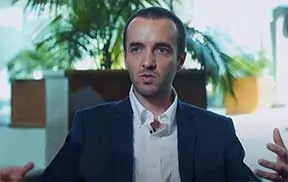
SCS RMC’s Business Manager is David Hostetter. His experience includes remote monitoring and controls systems engineering, construction, and operation; landfill gas and leachate engineering; and mechanical engineering. Dave’s focus is on automating remote process control of landfill systems, landfill gas blower/flare stations, wellfield vacuum and flow, along with leachate and groundwater pumping systems, weather equipment, and air monitors.
As a landfill gas engineer, his impetus was to avoid production downtime and keep operations within regulatory mandates. He wanted his clients to see what was happening at any given time and be alerted to atypical conditions. As a landfill engineer, he knows that “prevention is better than cure,” as long as it’s cost-effective. Dave’s solution is to leverage the Internet of Things through SCS RMC systems. Each piece of equipment you want to monitor gets a sensor. His team configures each sensor or group of sensors to parameters based on his operator’s business needs and environmental reporting responsibilities. A local wireless network communicates with a base station providing continuous readings from each sensor.
RMC sends alerts if readings are outside an acceptable range or if an environmental threshold is nearing exceedance. Alerts go to the landfill’s designated staff or technicians via smartphones, computers, or tablets. From these devices, users access their interface to control, start, stop, and reset field systems and analyze system operation. They can also view data, graphs, tables, alarms, and reports.
That’s more than convenience; it saves labor dollars spent to diagnose and reset these systems and is especially valuable for remote landfills. By design, clients can enable custom authorization levels for their systems. Naturally, the analytical tools are easy to use, understand, and report, as he explains in his video.
Albert Einstein Said…
“You can’t solve a problem on the same level that it was created. You have to rise above it to the next level.” We’re not comparing ourselves to Einstein, but all three SCSers leading their teams know that compliance policy never stops changing, and landfills are unique beasts made up of complex systems that need balance to perform. Performance is based on daily decisions and landfill readings generating enormous amounts of data. SCS’s job is to make your job better by collecting those millions of data bits for analysis faster, helping landfill operators use the intelligence to identify the cause and appropriate response to hundreds of issues that are part of landfill or facility management.
The backbone of every service at SCS Engineers is to design and develop based on our clients’ specific needs. As innovators, our mission is to leverage proven technology to meet those needs. As our founders did, we strive to understand our clients’ current and future needs, then develop or integrate the appropriate technology to meet those needs.
SCS is one of the most experienced and successful environmental compliance, design-build, operations, and maintenance firms in the United States. No stand-alone technology company can substitute for our knowledge and hands-on experience with innovative landfill design, build, and operations.
Visit SCS Engineers to discover SCS eTools and SCS RMC capabilities. You’ll find case studies, technology awards, and more resources for using technology to manage labor, liquids, air monitoring, groundwater, volume, GHGs, and more
“An ounce of prevention is worth a pound of cure.” We’ve all heard that proverb before, and it’s true – it’s generally easier to stop something from happening than to repair the damage after it has happened.
This is almost always the case when it comes to environmental incidents – it is cheaper to prevent the incident from occurring than paying for the cleanup and impacts the incident caused. Many of SCS’s service areas are specifically focused on prevention and optimization – doing the job in ways that are better, safer, and more protective of human health and the environment.
Environmental insurance is a product that most SCS clients likely have in place in some form to protect their facilities, employees, and neighbors from the harmful impacts of incidents that can introduce contamination into the air, soil, groundwater, or surface water. The types of coverage provided by environmental insurance policies vary in both extent and cost, and many factors, one of which being risk, drive those costs. When an insurance company is underwriting coverage for a new or existing client, the risk associated with that coverage is carefully evaluated. What the client (insured) does, how they do it, their safety record, their history of previous environmental issues, and other factors are all taken into consideration when writing an environmental insurance policy and the associated premium and deductible are determined.
To reduce the up-front costs (the premium) associated with carrying the necessary and appropriate amount of environmental insurance, the insured can do several things. One is to increase their deductible, but in the event of an incident, that could end up costing the insured more on the back end (i.e., costs expended to investigate and remediate an incident). Insureds, their brokers, and the insurers will work closely to balance premium costs and deductibles so that the costs associated with addressing an incident are not detrimental.
An insured shouldn’t reduce the type and amount of coverage – that could put them in a bad financial (and legal!) position. A more prudent choice, one that has many potential positive aspects and makes sound business sense, is reducing risk and therefore the costs associated with an environmental insurance policy that is based on coverage and risk.
SCS Engineers develops proprietary remote monitoring and control software for landfills, manufacturing, and industrial facilities called SCS RMC®. The software provides remote real-time viewing, analysis, and control of equipment and systems critical to safe operations and production. A network of sensors and Machine-to-Machine (M2M) applications enable operations teams to be alerted immediately (via cell phones, computers, tablets) of any operational issues that could potentially result in an environmental incident.
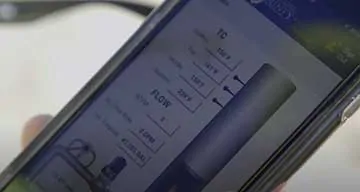
The application reduces reaction time, labor costs, and potential associated impacts. In this case, SCS RMC® puts the client’s decision-making in front of a problem rather than reacting to potential aftermaths, proactively reducing the potential environmental risks of their operations.
SCS’s service areas, including those listed here, are particularly focused on providing our clients with assistance in designing, building, and maintaining sustainable solutions, reducing risk, and helping to foresee and adapt to environmental, social, and regulatory changes:
SCS’s professionals are available to assist our clients in their discussions with brokers and insurers regarding how our environmental services and technologies can potentially reduce risks associated with their operations. We do this by providing creative and cost-effective solutions and guidance that can prevent environmental incidents from occurring and reducing the nature and extent of associated impacts.
We can help you select and implement the “ounce of prevention” so that you won’t have to face the “pound of cure.” This will proactively reduce operational risks, which can, in turn, help facilitate the positive brokering of more favorable environmental insurance coverage, premiums, and deductibles.
